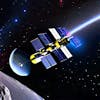S03E36: Stardust Revelations & The Enigma of Dark Matter

Prepare to journey through the cosmos with host Anna on today's episode of Astronomy Daily - The Podcast. We delve into a treasure trove of astronomical breakthroughs, from the discovery of ancient stardust that defies our solar system's norms to the...
Prepare to journey through the cosmos with host Anna on today's episode of Astronomy Daily - The Podcast. We delve into a treasure trove of astronomical breakthroughs, from the discovery of ancient stardust that defies our solar system's norms to the pioneering hunt for dark matter. We'll explore the origins of a supernova-born dust particle that challenges our astrophysical understanding and Yale University's innovative quest to capture the elusive axions that could unlock the mysteries of the universe's mass.
Then, witness the dawn of Europe's Ariane 6 rocket as it stands poised for its maiden voyage, symbolizing a leap forward in Europe's space aspirations. But it's not all smooth sailing; the Hubble Space Telescope faces a gyroscope challenge, testing NASA's resolve and ingenuity. We'll discuss the implications of this temporary setback and the anticipation of Hubble's return to its celestial watch.
The episode continues with the James Webb Space Telescope's surprising revelation of early galaxies' maturity, a finding that rewrites our narrative of cosmic evolution. Finally, we track the return of NASA's Dragon spacecraft, a beacon of scientific discovery, as it brings home invaluable research from the International Space Station.
Join us on this interstellar odyssey as we unpack these cosmic stories and ponder the ever-expanding frontiers of space exploration. This is Astronomy Daily - The Podcast, where every episode is a revelation of the universe's endless marvels.
---
**Featured Topics:**
1. **Ancient Stardust Mystery:** Unveiling the supernova origins of a meteorite's dust particle with unprecedented magnesium isotopic ratios.
2. **Dark Matter's New Hope:** Yale's axion detection experiment and the metamaterials revolutionizing our cosmic search.
3. **Ariane 6's Inaugural Campaign:** Europe's monumental step towards sovereign space exploration.
4. **Hubble's Gyroscope Woes:** Navigating the challenges of space technology and the resilience of NASA's iconic telescope.
5. **James Webb's Galactic Insights:** The unexpected early maturity of ancient galaxies and the rethinking of universal history.
6. **Dragon's Scientific Bounty:** NASA's spacecraft returns with a cache of knowledge from the orbital frontier.
---
**Additional Information:**
For more cosmic content, visit astronomydaily.io, and stay connected with us on X (@AstroDailypod) for the latest updates and stellar news. Until next time, this is Anna, reminding you to keep your eyes on the skies and your mind on the wonders above. Clear skies and boundless curiosity to all our fellow stargazers!
This episode is brought to you by NordPass, the password manager that secures your celestial data. To grab our special offer and find out more, visit www.bitesz.com/nordpass
Become a supporter of this podcast: https://www.spreaker.com/podcast/astronomy-daily-the-podcast--5648921/support
#space #astronomy #news #podcast #thestorieswetold
AI Transcript
Astronomy Daily explores the latest astronomical discoveries and discusses their implications
Anna: Welcome to Astronomy Daily, the podcast. The podcast that takes you on an auditory journey through the cosmos. Today, we explore a, selection of the latest astronomical discoveries and discuss their implications on our understanding of the universe. From groundbreaking revelations about ancient stardust to the hunt for the enigmatic dark matter. The beginning of Ariane Six's inaugural flight campaign, the Hubble Space Telescope's current challenge to the unexpected findings by the James Webb space telescope, and the scientific treasures brought back to Earth by NASA's dragon spacecraft. We're diving deep into these cosmic stories, breaking down their significance, and contemplating the ever expanding frontiers of space exploration. Join us as we unravel the marvels of the universe, one discovery at a time. The astronomy daily podcast.
Scientists discover rare magnesium isotopic ratio in remnants of a meteorite
In a fascinating turn of events that's challenging our grasp of the heavens, scientists have uncovered a truly exceptional find within the remnants of a meteorite. It's a rare dust particle, carrying within it the signature of origins beyond the reaches of our sun. A whisper from a hydrogen burning supernova. What's most remarkable is the magnesium isotopic ratio present in this particle. This ratio strays far from anything we might expect to see within the confines of our own solar system, diverging so significantly that it sends current astrophysical models into question. These presolar grains, as we call them, are almost like messengers from the archaic universe, captured in the meteoritic material and carrying the history of stars that outdate our sun. Doctor Nicole Neville and her team used innovative atom probe tomography, developing a detailed snapshot of this particles atomic makeup. Imagine typical magnesium isotopic ratios found in these grains from previous studies, capped at around 1200, presumably the highest until now. The particulate in question. It boasts a staggering ratio of 3025, unheard of. This finding not only expands our knowledge of stardust, but implies the existence of celestial phenomena that we are only just beginning to understand. The hydrogen burning supernova, a recent yet profound discovery. Co author doctor David Saksy emphasized how the atom probe has laid bare details that had previously remained concealed in the dusty vaults of space. The utility of this method underscores a breakthrough in both technological prowess and our cosmic awareness. It's these tiny particles, seemingly insignificant, that prop open the door to more nuanced narratives of our universe's expansive history. This discovery is a testament to the notion that the cosmos still holds many secrets. And as we peel back the layers, we're continually reminded that what we know is just a sliver of what's out there to be discovered. As we probe the shadows of the cosmos, Yale University presents a new tactile in the quest to demystify dark matter, the elusive substance that comprises about 85% of the universe's massive. For decades, scientists have grappled with the challenge of detecting dark matter, which neither emits nor absorbs light, rendering it essentially invisible to conventional telescopes. But a novel experiment now underway is bringing us tantalizingly close to, perhaps, one of the most significant discoveries in astrophysics. At the heart of this investigation are axions, hypothetical particles that could solve two of the most perplexing enigmas in science. Axions are not only a beacon of hope in the search for dark matter, but also might resolve the mysterious absence of an electric dipole moment in neutrons. If they exist, axions would be incredibly light and only weakly interact with other particles. Yet their implications for our understanding of the fundamental forces of nature are profound. To capture these spectral particles, researchers at Yale are deploying a groundbreaking device called the axion longitudinal plasma heloscope. This instrument heralds the use of cutting edge metamaterials, materials engineered to have properties that are not found in nature. Envisage a cavity filled with carefully arranged conductive rods, working to create an effective illusion, a space that resonates with the frequency of microscopic axions, akin to dialing into a faint radio signal in a sea of static. This metaphysical marvel of a cavity manipulates the fabric of space within, appearing as if it were a million times smaller while maintaining its original volume. Such a design increases the likelihood of detecting axions and adjusts with ease to scan a wide range of frequencies where these elusive particles might be hiding. What's at stake here is nothing less than a paradigm shift in the understanding of our universe. Axions may illuminate the shadowy canvas of the cosmos, offering not just an insight into what holds the stars and galaxies together, but also rendering clear the very nature of reality itself. The quest for this celestial detective story is long and arduous. But with ingenuity and a touch of subatomic finesse, Yale's explorers stand poised to bring the universe's most significant secrets into the light. In a momentous event for european space aspirations, the Ariani Six rocket has officially initiated its inaugural launch campaign. The rockets central core, alongside its imposing boosters, now stand assembled on the storied launchpad at Europes spaceport in Coorau, French Guiana. This culminating point signifies years of rigorous engineering and collaboration across multiple european aerospace entities. One cannot help but marvel at the intricate choreography required as automated guided vehicles and cranes maneuvered the colossal structures, reflecting humanity's relentless pursuit to reach beyond our terrestrial confines. As we anticipate the Ariane Six's first journey skywards, the amalgamation of ambition and technology before us is not just a testament to progress, but also a beacon of future possibilities. With this step, Europe reasserts its fiercely independent stride towards achieving sovereign access to the boundless expanse of space. As the Ariani six ascends, it shall carry with it the collective aspirations of a continent committed to expanding the frontiers of human knowledge.
A gyroscope issue has put NASA's Hubble Space Telescope into safe mode
Attention to all space enthusiasts and astronomy professionals. An important update from the Hubble front NASA's venerable Hubble Space Telescope has momentarily ceased its watchful gaze over the cosmos. The cause, a gyroscope issue has thrust this unparalleled observatory into safe mode. What this means for Hubble is that, for the time being, all scientific toiling and astronomical observations are suspended. The gyroscope at the heart of this interruption serves as the celestial compass for the telescope, dictating the precision of its aim as it pivots through the void. Upon registering anomalous readings from one of its three gyros, the failsafe measures aboard the space telescope immediately initiated a protective configuration, forestalling further engagements with the heavens. In November, this identical gyro ushered Hubble into the same state. After presenting similarly erroneous data, the adept teams at NASA are now diligently sifting through a spectrum of potential corrective strategies to navigate this hurdle. If imperative, the telescope has the capability of reverting to a one gyro operation, maintaining the second as a contingency. This workaround is a testament not only to Hubble's resilient design, but also to its foundational role in humanity's pursuit of astronomical enlightenment. Launched into orbit in the spring of 1990, Hubble has since unfurled the universe's wonders to us for over three decades. Its illustrious career is studded with a medley of groundbreaking revelations that have propelled our cosmic comprehension forward. And even as we encounter this gyroscope tribulation, NASA remains optimistic with the tenacity that characterizes all great scientific endeavors. The expectation is that this beacon of exploration will resume its synergy with our other observatories, including the heralded James Webb Space Telescope, throughout the remainder of this decade and into the next.
James Webb Space Telescope reveals surprising evolution of early galaxies
A beacon of knowledge, a light across the eons, the astronomy daily podcast peering into the depths of the cosmos like never before, the James Webb Space Telescope has unveiled an unexpected twist in our narrative of the early universe. It appears that galaxies were on a fast track to adulthood, exhibiting a level of maturity that has taken astronomers by surprise an international team spearheaded by researchers from Durham University has observed astonishing structures known as star bars, within galaxies that glittered into existence a mere few billion years post the Big Bang. These star bars are elongated regions brimming with stars at the cores of spiral galaxies, much akin to our own galactic home, the Milky Way. Their significance can't be overstated. They act as cosmic conveyor belts, funneling gas to galactic centers and regulating stellar births. The discovery of these central structures suggests that these nascent galaxies found their rhythms surprisingly early, transitioning into a settled and mature phase much quicker than we had imagined. The revelation has prompted a re examination of our understanding of galactic evolution. In the early universe, the dance of the galaxies wasn't as wild and chaotic as we previously believed. Rather, there was an underlying order, a rapid progression towards a, structured galactic existence. This information necessitates revising our models of the universe's formative epics. What these findings underscore is the inexhaustible potential of the James Webb Space Telescope. It continues to expand our cosmic horizons, revealing that bar features were omnipresent in the earlier universe at rates double those recorded by Hubble. This nuanced portrait of the universe's youthful epochs challenges us to redefine what we thought we knew and keeps us eagerly awaiting the secrets yet to be unveiled by this monumental observatory.
NASA's dragon spacecraft will return to Earth on Sunday with live coverage
In an extraordinary voyage back to Earth, NASA's dragon spacecraft prepares to undock from the International Space Station. Having served as a temporary laboratory in the stars, the spacecraft will return home on Sunday, with NASA providing live coverage, weather permitting, dragon is packed with critical scientific experiments and precious research outcomes that will inform future voyages and enrich our understanding of space. Through the teeming quiet of the cosmos, this vessel will navigate the incandescent descent through our planet's atmosphere, safeguarding the trove of information gathered in orbit. The departure of dragons symbolizes a vital cycle in space exploration, the handoff from the expanse of the void to the hands of earthbound scientists eagerly awaiting their data. It's not just a return. It's a homecoming for knowledge that could one day shape the fabric of humanity's destiny among the stars. Watch the skies for dragon's fiery trail as it carries its bounty from the confines of space to the laboratories that await its descent. The curiosity that fuels such missions is the same that has long gazed upward, pondering what lies beyond our celestial cradle. Thank you for joining us, on Astronomy daily, the podcast. It's been an incredible journey through the cosmos today, one that reminds us just how endlessly fascinating our universe is for more cutting edge discoveries and insights into the ever expanding frontiers of space and astronomy. Dont forget to visit our website at astronomydaily IO. Stay connected and continue to fuel your curiosity by following us on X, formerly known as Twitter stroDailypod, where we share cosmic updates and the latest stellar news. Until next time, this is Anna signing off and reminding you to keep your eyes on the skies and your mind on the wonders above. It's Astronomy Daily the stories we told The Stories we told
New to Astronomy Daily - The Podcast?
Here are some great episodes to start with.














